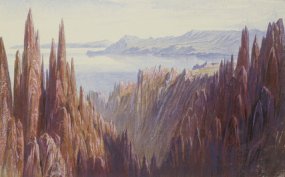 Edward Lear (1812-1888) is probably best known for the limericks and nonsense rhymes of his Book of Nonsense (1846) but he was also an accomplished and well-travelled zoological, botanical and landscape artist.
Edward Lear (1812-1888) is probably best known for the limericks and nonsense rhymes of his Book of Nonsense (1846) but he was also an accomplished and well-travelled zoological, botanical and landscape artist.
He was the twentieth of twenty-one children born into a middle-class family in what was then the village of Holloway near London. When the family fell on hard times, his parents abandoned him and he was brought up by two older sisters. He showed early talent and soon developed into a serious ornithological draughtsman employed by the Zoological Society and then by the Earl of Derby who kept a private menagerie.
Lear’s first publication was Illustrations of the Family of Psittacidae, or Parrots (1830). His paintings were well received and he was compared favourably with the naturalist Audubon. He was also a pianist and composer and specialised in musical settings of Tennyson poems, which the poet himself approved of. Lear seems not to have had much success with relationships. He formed a passionate long-term attachment to a barrister, Franklin Lushington, but these feelings were not reciprocated with the same intensity
He visited Albania, Egypt, Germany, Greece, Italy, India and Sri Lanka among other countries. While travelling he produced large quantities of beautiful and distinctive coloured wash drawings which he converted later in his studio into oil and watercolour paintings as well as prints for his travel books.
His landscapes are often dramatic views with strong light and dark, intense contrasts of colour and a preference for romantic, jagged mountainscapes.
He toured Corsica in 1868 and his striking renderings of the coast near Piana and the Forest of Valdoniello are representative of the work the island’s varied landscape inspired in him. The record of his travels, Journal of a Landscape Painter in Corsica (1870) contributed to making Corsica fashionable among the more adventurous Victorian travellers around a century after James Boswell’s An Account of Corsica had brought the island to the attention of Georgian readers in 1768.
At the start of the journal, Lear shares some of his pre-travel anxieties:
Will there be anything worth seeing in Corsica? Is there any romance left in that island? Is there any sublimity or beauty in its scenery? Have I taken too much baggage? Have I not rather taken too little? Am I not an idiot for coming at all? Thus, and in such a groove, did the machinery of thought go on, gradually refusing to move otherwise than by jerky spasms…Are there not Banditti?
Once on the island, he was very taken by the Corsican maquis:
…the excessively rich foliage which is the characteristic clothing of the all the hills. This ‘maquis’ or robe of green covering every part of the landscape except the farthest snowy heights, is beyond description lovely, composed as it is of myrtle, heath, arbutus, broom, lentisk and other shrubs, while, wherever there is any open space, innumerable crimson cyclamen flowers dot the ground and the picturesque but less beautiful hellebore flourished abundantly. There groups of ilex or chestnut rise above the folds of exquisite verdure…
Lear was critical of the Corsican practice of vendetta; long-term grudge-bearing which often led people to violent revenge:
If a man had received an injury, and could not find a proper opportunity to be revenged on his enemy personally, he revenged himself on one of his enemy’s relations. So barbarous a practice was the source of innumerable assassinations.
Overall, he felt that Corsica had some way to go before fulfilling its potential:
The position of Corsica, its climate, its fertility, the brilliant qualities of its people, unite to claim attention to this privileged spot. Unhappily, labour has not as yet called forth its natural riches, rivalries are transmitted from father to son for years and the population, idle in the midst of universal progress, seems condemned to a fatal immobility.
Economically and socially things have moved on since then, but the distinctive maquis which Lear experienced is still omnipresent.
There is little evident crossover from Lear’s travels to his nonsense rhymes, but at least one of his limericks features a Corsican character if not a Corsican theme:
There was a young lady of Corsica,
Who purchased a little brown saucy-cur;
Which she fed upon ham
And hot raspberry jam,
That expensive young lady of Corsica.
Another Lear limerick:
There was an old man of the South,
Who had an immoderate mouth;
But in swallowing a dish,
That was quite full of fish,
He was choked, that old man of the South.
has been translated into Corsican by Marcu Biancarelli as:
Era un avu ‘llu meziornu
A bucca com’e un fornu
Ma inguttindusi un piatu
Di peciu appruntatu
Si sturzo, quidd’avu ‘llu meziornu.
(from Mediterraneans magazine, summer 2001)
A facsimile of the entire Journal of a Landscape Painter in Corsica is available here.
See also:
John Minton in Corsica (July 2015)
Paoli in London (March 2015)
Conrad in Corsica (August 2014)
Seneca in Corsica (August 2014)
Corsican proverbs and sayings (August 2014)
Corsica: a poem (July 2015)



Eddie
These Corsican posts are ace! Thanks
And, of course, there is Lear’s recently discovered work:
A beauty from just outside Bastia
Had a boyfriend who couldn’t be nastier
But after a tiff
On the edge of a cliff
She pushed, shouting, “May that be the last o’yer.”
Kevin
_____
LikeLike
Kevin, thanks for sharing this excellent ‘discovery’, I’m sure Lear would approve.
LikeLike